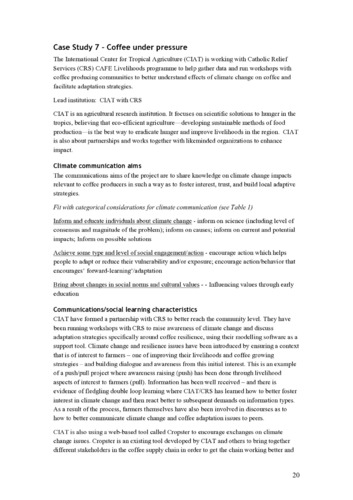Coffee Under Pressure
Abstract
Context: Vulnerability of farmers equals vulnerability of supply chain. Inclusive management involves those that contribute to growing, selling and changing strategies. Crop modelling under different climate conditions requires knowledge of who’s growing, selling and involved in the supply chain. It also requires an analysis of who the beneficiaries of the value chain are and who will be adversely affected by changes in climate and in practice in order to identify appropriate adaptation strategies. Gender analysis is critical.
Interface: Researchers and stakeholders such as farmers, extensionists, local governments, and ministers are brought together in workshops to discuss history, crop types and harvesting methods and climate change perceptions. Strategies such as visual questionnaires, maps, and models of 20-year crop/climate projections are used to engage and discuss how resources change over time.
Learning: Knowledge and networks from collaborative teams are leveraged in order to mobilize practical tools, systems and practices that build adaptive capacity among the poor and among women. Young people understand much faster about climate change. Youth and women are more engaged in participatory workshops. Interactive approaches feed information back into more relevant crop/climate models.
Channel: Working with intermediaries such as Oxfam has contributed to ways of integrating gender-sensitive methods into the research process. The collaboration has provided Oxfam with CIAT’s relevant crop/climate expertise and information, and providing an avenue for research to be disseminated more broadly.
Engaging with global food companies has typically included Corporate Social Responsibility departments. There is a recognized need that corporate buyers need to be brought into the collaborations in order to mainstream sustainable supply chains more broadly.
A gender expert within CIAT is facilitating learning about the need for differentiated gender components in research. Agronomists are paying attention and using this resource now that the need has been identified within the institution.
Outcome: Learning that women play a significant role in the supply chain but do not get shares of revenue leads to new research questions about what varieties and practices contribute to more visible and greater involvement. Oxfam included post-harvest facilities in the supply chain, formalizing women’s involvement in the supply chain and ability to generate income.
Funding is viewed as a primary barrier to longer term learning cycles and for building continuous partnerships and trust over time. CIAT is working collaboratively with supply chain stakeholders and making links with large development NGOs, to use one part (approx. 8%) of their funding for relevant scientific research that applies to local development projects. Where possible, it is expected that sampling design and the innovative methodologies developed can then be rolled out across extensive NGO networks, including Oxfam and Catholic Relief Services.

